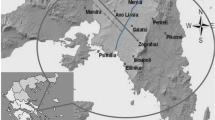Abstract
The threshold method estimates the total rainfall F G in a region G using the area B G of the subregion where rainfall intensity exceeds a certain threshold value c. We model the rainfall in a region by a marked spatial point process and derive a correlation formula between F G and B G. This correlation depends not only on the rainfall distribution but also on the variation of number of raining sites, showing the importance of taking account of the spatial character of rainfall. In the extreme case where the variation of number of raining sites is dominant, the threshold method may work regardless of rainfall distributions and even regardless of threshold values. We use the lattice gas model from statistical physics to model raining sites and show a huge variation in the number of raining sites is theoretically possible if a phase transition occurs, that is, physically different states coexist. Also, we show by radar observation datasets that there are huge variations of raining sites actually.
Similar content being viewed by others
References
Bolthausen, E. (1982). On the central limit theorem for stationary mixing random fields, Ann. Probab., 10, 1047–1050.
Braud, I., Creutin, J. D. and Barancourt, C. (1993). The relation between the mean real rainfall and fractional area where it rains above a given threshold, Journal of Applid Meteorology, 32, 193–202.
Chiu, L. S. (1988). Rain estimation from satellites: Areal rainfall-rain area relations, Paper 7.14, Reprints, Third Conf. on Satellite Meteorology.
Föllmer, H. (1982). A covariance estimate for Gibbs measures, J. Funct. Anal., 46, 387–395.
Georgii, H.-O. (1988). Gibbs Measures and Phase Transitions, Walter de Gruyter, Berlin.
Patterson, V. L., Hudlow, M. D., Pytlowany, P. J., Richards, F. P. and Hoff, J. D. (1979). GATE radar rainfall processing system, NOAA Technical Memo., EDIS 26.
Prum, B. and Fort, J. C. (1991). Stochastic Processes on a Lattice and Gibbs Measures, Kluwer, Dordrecht.
Ruelle, D. (1969). Statistical Mechanics: Rigorous Results, Benjamin, New York.
Ruelle, D. (1978). Thermodynamic Formalism: The Mathematical Structures of Classical Equilibrium Statistical Mechanics, Addison-Wesley, London.
Shimizu, K. (1992). The estimation of area rain rate characteristics by the threshold method, Journal of Japan Applied Statistical Society, 21, 133–151 (in Japanese).
Shimizu, K., Kedem, B. and Short, D. A. (1993). Single- and double-threshold methods for estimating the variance of area rain rate, Journal of the Meteorological Society of Japan, 71, 673–683.
Short, D. A., Shimizu, K. and Kedem, B. (1993). Optimal thresholds for the estimation of area rain-rate moments by the threshold method, Journal of Applied Meteorology, 32, 182–192.
Author information
Authors and Affiliations
About this article
Cite this article
Mase, S. The threshold method for estimating total rainfall. Ann Inst Stat Math 48, 201–213 (1996). https://doi.org/10.1007/BF00054785
Received:
Revised:
Issue Date:
DOI: https://doi.org/10.1007/BF00054785




